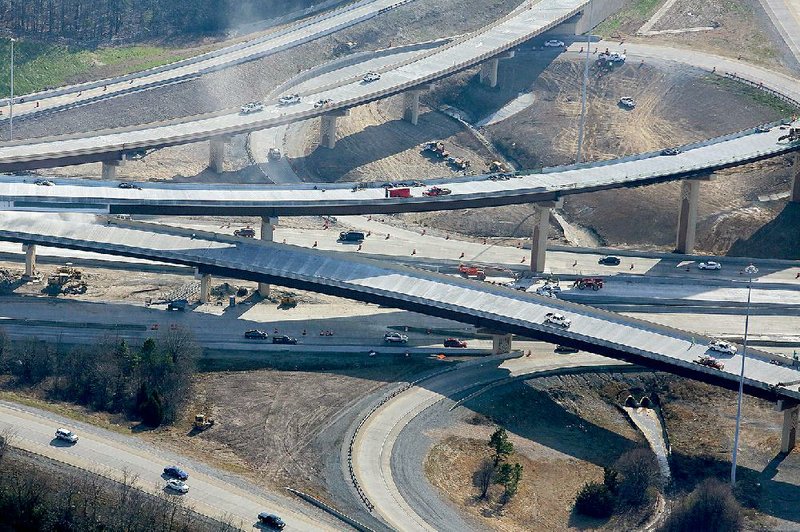JEFFERSON CITY, Mo. -- Touted as one of the first interstate highways, a 200-mile span of Interstate 70 between suburban St. Louis and Kansas City stands as a prime example of the infrastructure challenges the nation faces.
Built in the 1950s and '60s with a 20-year life expectancy, the four-lane highway is crumbling beneath its surface and is clogged with traffic, carrying more than 30,000 vehicles a day on many of its rural stretches and requiring more frequent repaving. The cost to rebuild and widen it is estimated at $2 billion to $4 billion -- as much as five times the projected yearly construction and maintenance budget of Missouri's transportation department.
And there is no easy way to pay for it. The state fuel tax hasn't risen in about 20 years, and voters defeated a 1 percent sales tax for transportation. Gov. Jay Nixon has floated the idea of increasing the gasoline tax and reviving a previously failed plan to turn I-70's reconstruction over to a private entity that could charge tolls estimated at up to $30 per car.
As legislatures convene across the country, lawmakers and governors are confronting similar realities in their own states: an aging network of roads, highways and bridges and an era in which federal money for such projects has remained stagnant or declined.
Nationally, an Associated Press analysis of federal highway spending shows that the money available to all states from the Federal Highway Trust Fund declined 3.5 percent in the five years that ended in 2013, the latest year for which figures are available. During that time, the amount of inflation-adjusted federal highway money dropped in all states but Alaska and New York.
In Arkansas, money from the federal trust fund decreased by almost 5 percent, from $550 million to $523 million over the same period, the AP analysis shows.
Yet, the Arkansas Highway and Transportation Department increased spending 70 percent over the five years, according to Federal Highway Administration statistics.
Arkansas taxpayers helped alleviate some of the squeeze from the declining federal dollars. In 2011, state voters approved the renewal of a bond program for interstate highway maintenance, and in 2012, voters authorized a 0.5 percent increase in the state sales tax to go toward highway projects.
Together, the two programs are providing about $3 billion for construction on projects covering 630 miles of road, or 3.8 percent of the state's total highway miles. The programs are to expire in about seven years.
Arkansas transportation officials, like their counterparts in other states, say more funding options are needed to pay for much-needed improvements to rapidly aging roadways.
Last week, a state House committee endorsed a bill that would move nearly $2.8 billion in state general revenue to road construction over 10 years. A similar proposal withered in committee two years ago, and Gov. Asa Hutchinson has signaled his opposition to the new bill.
Compounding the problem with Arkansas' funding outlook is increasing construction costs, said Highway Department Director Scott Bennett. The department projects $20.4 billion in needs and $3.6 billion in available revenue over the next 10 years.
Highway Department programs are paid for primarily through gasoline and diesel taxes, which have decreased as vehicles become more efficient. Both the state and federal government are collecting less from such taxes.
Bennett said about $1.1 billion in highway improvements over the next two years are in jeopardy because of the condition of the federal fund, and the state has already cut $60 million worth of highway projects this year in anticipation of the dwindling federal flow.
"There has got to be a higher level of investment in highways at the federal and the state level. There's no two ways about it," Bennett said. "The revenue we receive has not even come close to keeping up with inflation."
If that doesn't happen, Bennett said, the public can expect highways to become more deteriorated and congested.
Nationwide conundrum
Nearly two of every 9 miles of the nation's 900,000 miles of interstate and major roads need resurfacing or reconstruction, according to federal data analyzed by the American Road and Transportation Builders Association.
A quarter of the nation's 600,000 bridges are in such poor condition that they are rated as structurally deficient or are considered functionally obsolete because they have narrow lanes or other features not designed for today's traffic.
The funding shortfall has led to rougher roads that require more frequent, short-term repairs, and to jammed commuter routes that simply have more vehicles on them than the roads were designed to carry.
On Missouri's I-70, the surface remains relatively smooth, but its weakening foundation means the state must pay to repave it more frequently. Whenever a lane closes, traffic backs up for miles.
On one recent afternoon, the congestion forced Tom Crawford to drive his Dodge Durango about 10 miles under the speed limit. Behind him, two trucks with oversize loads were backing up traffic. In front of him was a long line of blinking red taillights.
"We've got trucks and cars that are just bumper to bumper -- people hitting their brakes," Crawford, president and chief executive of the Missouri Trucking Association, said in a cellphone interview from the highway.
The increased congestion on I-70 often lengthens the time truckers are on the road, he said, potentially raising their costs.
Drumbeat grows
Calls for more funding have been getting louder in state and local governments, not just in Arkansas. This year, as many as one-third of state legislatures have transportation funding increases on their agendas. That comes after roughly one-fourth of the states increased transportation taxes or fees during the past two years.
The state proposals stand in stark contrast to the inaction in Congress, where a temporary funding patch is scheduled to expire in May and lawmakers have been at odds over a long-term highway plan. A federal fuel-tax increase appears unlikely.
Earlier this month, President Barack Obama proposed a six-year, $478 billion program to pay for highway, transit and infrastructure upgrades, with funding roughly split between the current fuel taxes and a tax on the foreign profits of U.S. corporations. How much of that plan survives Congress, where majority Republicans seek to limit government spending and reduce taxes, will not be determined for months.
Obama's 2009 stimulus act provided a brief spike in transportation funding. But the annual amount available to states from the Federal Highway Trust Fund has hovered around $40 billion since 2007.
Even though total state and federal road funding exceeded the general rate of inflation over the past decade, the pace has tapered off in recent years as the amount coming from the federal government declined.
The American Association of State Highway and Transportation Officials estimates that annual road and bridge spending by all levels of government is falling $32 billion short of what is needed.
The flat federal funding is having an impact because states rely on federal dollars for an average of half of their capital expenses for roads and bridges, according to the American Road and Transportation Builders Association. The rest is covered with state money, which comes predominantly from fuel taxes.
Stagnant revenue
Gasoline-tax revenue has grown little since 2007 -- and actually declined on an inflation-adjusted basis, according to some analysts -- as vehicles have become more fuel-efficient and people cut back on driving.
"The method that we use to fund transportation -- the primary method, the motor fuels tax -- is a model that doesn't work anymore," said David Ellis, the top infrastructure investment analyst at the Texas A&M Transportation Institute.
To compensate, lawmakers in Maryland, Massachusetts, New Hampshire, Pennsylvania and Wyoming passed gasoline-tax increases during the past two years. But about half of the states have not raised their gasoline taxes in at least a decade, and the federal gas tax has remained at 18.4 cents a gallon since 1993.
Arkansas' Legislature last raised the state gasoline tax in 1999, but the 3-cent increase was phased in over three years. It is now 21.5 cents a gallon.
The state diesel tax also was last raised in 1999. Its 4-cent increase was phased in over two years. It now is 22.5 cents a gallon.
Proceeds from the diesel tax are used as a local match to pay off debt on the interstate repair program. The 3-cent gasoline-tax increase is intended for non-interstate road repairs.
Although some members of Congress have expressed a willingness to consider an increase in the federal tax, House and Senate Republican leaders have said there aren't enough votes to pass a gas-tax increase. Many states are now considering alternative ways of paying for roads.
Virginia recently scrapped its per-gallon gasoline tax in favor of a new tax on the wholesale price of gas and a higher tax on other retail sales. The state also has turned to public-private partnerships to build projects.
Among them are new express lanes that opened in December on Interstate 95 in northern Virginia, a $925 million project financed partly by private investors who have a long-term contract to collect tolls.
Lawmakers in Minnesota, Utah and Missouri also are expected to consider proposals this year that could levy a sales tax on fuel, allowing the states to reap more money when the price of gasoline rises. And Michigan voters will decide in May on a 1 percent general sales tax for transportation.
In his inaugural address last month, California Gov. Jerry Brown cited $59 billion in needed maintenance on roads and bridges in the nation's most populous state. He said the state was falling "further and further behind," but he did not offer specifics on how to address the deficit.
Most states are simply looking to maintain their current highway system rather than add to it, said Jim Tymon, director of policy and management at the American Association of State Highway and Transportation Officials.
"A lot of those facilities are in need of really massive rehab, almost reconstruction from the ground up," he said.
Information for this article was contributed by Noel Oman of the Arkansas Democrat-Gazette.
SundayMonday on 02/22/2015


